Bacteriological Profile of Bloodstream Infection in Hospitals
VerifiedAdded on 2022/08/24
|16
|4760
|15
Report
AI Summary
This report provides a comprehensive overview of bacteraemia, focusing on its bacteriological profile and impact within a hospital setting. It defines bacteraemia, explores its causes, including both gram-positive and gram-negative bacteria such as Staphylococcus, Streptococcus, and Enterococcus species, and discusses the various risk factors like immunodeficiency and nosocomial infections. The report delves into the body's defense mechanisms, including innate and adaptive immune responses, the role of complement, and the function of the liver and spleen in fighting infection. It details clinical signs and symptoms, such as fever, chills, and abnormal heart rate, as well as the complications associated with bacteraemia, including pneumonia, meningitis, and sepsis. Additionally, the report highlights the growing concern of antimicrobial resistance, particularly MRSA, and its implications for patient outcomes. Overall, the report offers valuable insights into the complexities of bloodstream infections and the critical need for effective prevention and management strategies within healthcare environments.
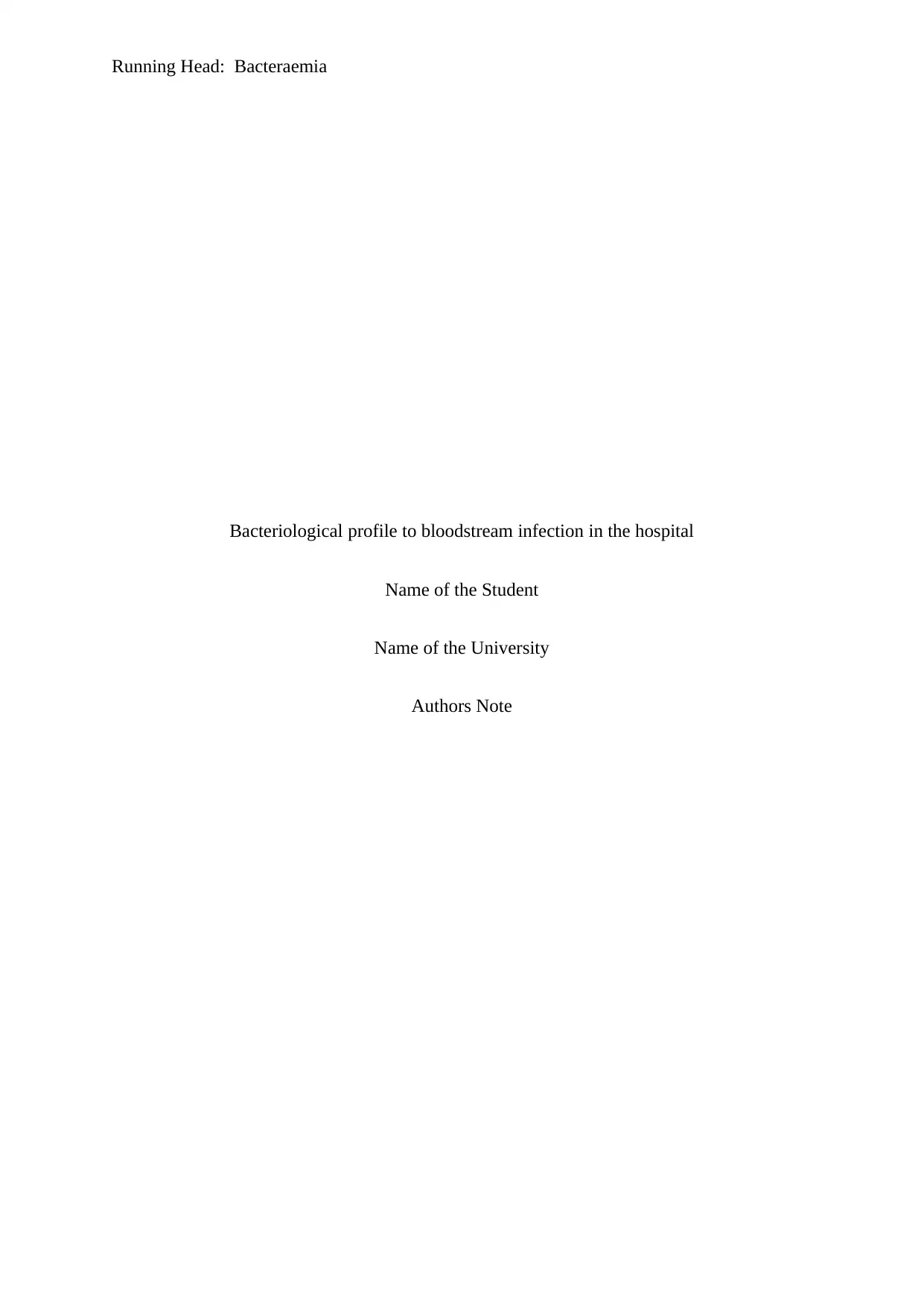
Running Head: Bacteraemia
Bacteriological profile to bloodstream infection in the hospital
Name of the Student
Name of the University
Authors Note
Bacteriological profile to bloodstream infection in the hospital
Name of the Student
Name of the University
Authors Note
Paraphrase This Document
Need a fresh take? Get an instant paraphrase of this document with our AI Paraphraser
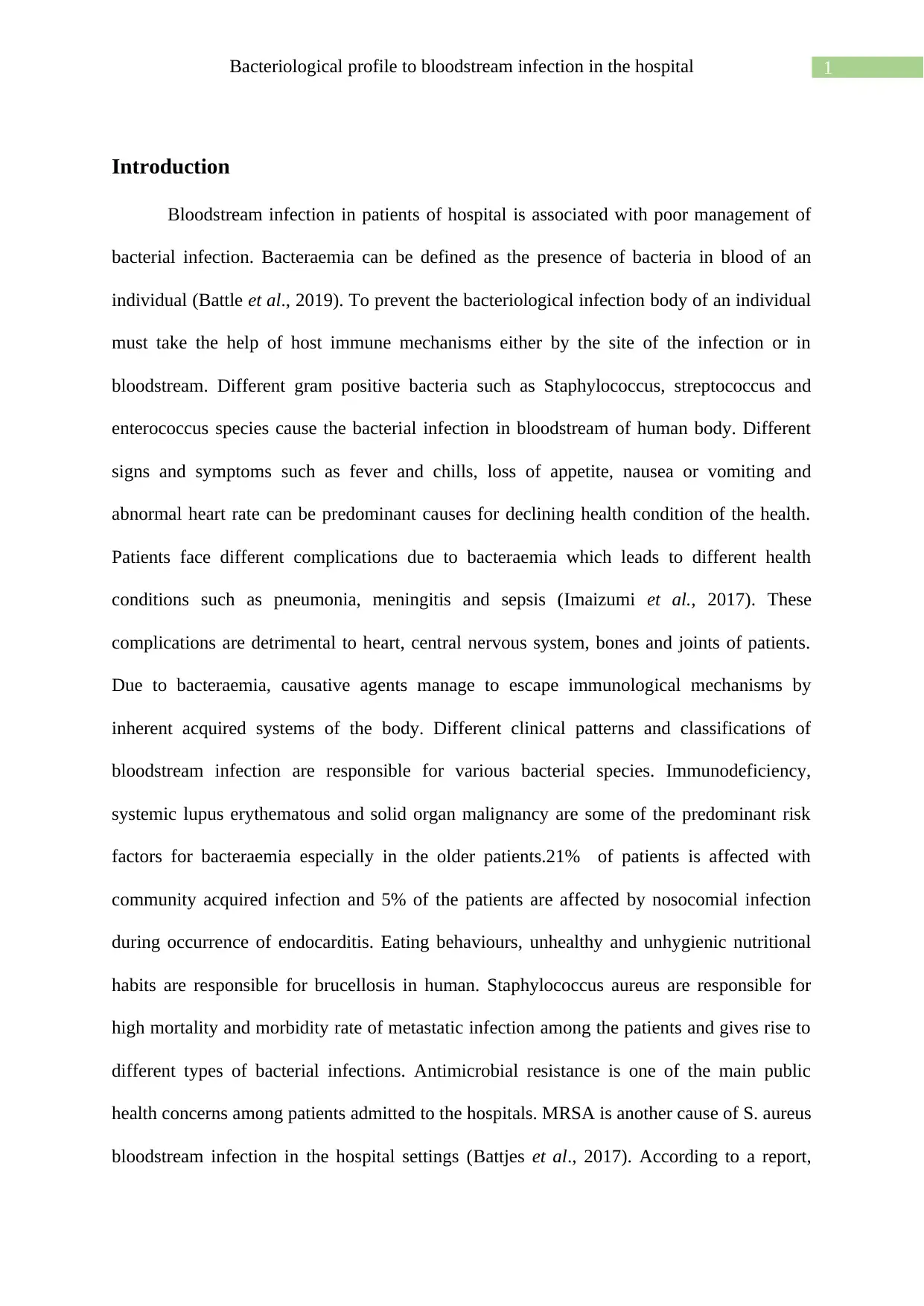
1Bacteriological profile to bloodstream infection in the hospital
Introduction
Bloodstream infection in patients of hospital is associated with poor management of
bacterial infection. Bacteraemia can be defined as the presence of bacteria in blood of an
individual (Battle et al., 2019). To prevent the bacteriological infection body of an individual
must take the help of host immune mechanisms either by the site of the infection or in
bloodstream. Different gram positive bacteria such as Staphylococcus, streptococcus and
enterococcus species cause the bacterial infection in bloodstream of human body. Different
signs and symptoms such as fever and chills, loss of appetite, nausea or vomiting and
abnormal heart rate can be predominant causes for declining health condition of the health.
Patients face different complications due to bacteraemia which leads to different health
conditions such as pneumonia, meningitis and sepsis (Imaizumi et al., 2017). These
complications are detrimental to heart, central nervous system, bones and joints of patients.
Due to bacteraemia, causative agents manage to escape immunological mechanisms by
inherent acquired systems of the body. Different clinical patterns and classifications of
bloodstream infection are responsible for various bacterial species. Immunodeficiency,
systemic lupus erythematous and solid organ malignancy are some of the predominant risk
factors for bacteraemia especially in the older patients.21% of patients is affected with
community acquired infection and 5% of the patients are affected by nosocomial infection
during occurrence of endocarditis. Eating behaviours, unhealthy and unhygienic nutritional
habits are responsible for brucellosis in human. Staphylococcus aureus are responsible for
high mortality and morbidity rate of metastatic infection among the patients and gives rise to
different types of bacterial infections. Antimicrobial resistance is one of the main public
health concerns among patients admitted to the hospitals. MRSA is another cause of S. aureus
bloodstream infection in the hospital settings (Battjes et al., 2017). According to a report,
Introduction
Bloodstream infection in patients of hospital is associated with poor management of
bacterial infection. Bacteraemia can be defined as the presence of bacteria in blood of an
individual (Battle et al., 2019). To prevent the bacteriological infection body of an individual
must take the help of host immune mechanisms either by the site of the infection or in
bloodstream. Different gram positive bacteria such as Staphylococcus, streptococcus and
enterococcus species cause the bacterial infection in bloodstream of human body. Different
signs and symptoms such as fever and chills, loss of appetite, nausea or vomiting and
abnormal heart rate can be predominant causes for declining health condition of the health.
Patients face different complications due to bacteraemia which leads to different health
conditions such as pneumonia, meningitis and sepsis (Imaizumi et al., 2017). These
complications are detrimental to heart, central nervous system, bones and joints of patients.
Due to bacteraemia, causative agents manage to escape immunological mechanisms by
inherent acquired systems of the body. Different clinical patterns and classifications of
bloodstream infection are responsible for various bacterial species. Immunodeficiency,
systemic lupus erythematous and solid organ malignancy are some of the predominant risk
factors for bacteraemia especially in the older patients.21% of patients is affected with
community acquired infection and 5% of the patients are affected by nosocomial infection
during occurrence of endocarditis. Eating behaviours, unhealthy and unhygienic nutritional
habits are responsible for brucellosis in human. Staphylococcus aureus are responsible for
high mortality and morbidity rate of metastatic infection among the patients and gives rise to
different types of bacterial infections. Antimicrobial resistance is one of the main public
health concerns among patients admitted to the hospitals. MRSA is another cause of S. aureus
bloodstream infection in the hospital settings (Battjes et al., 2017). According to a report,
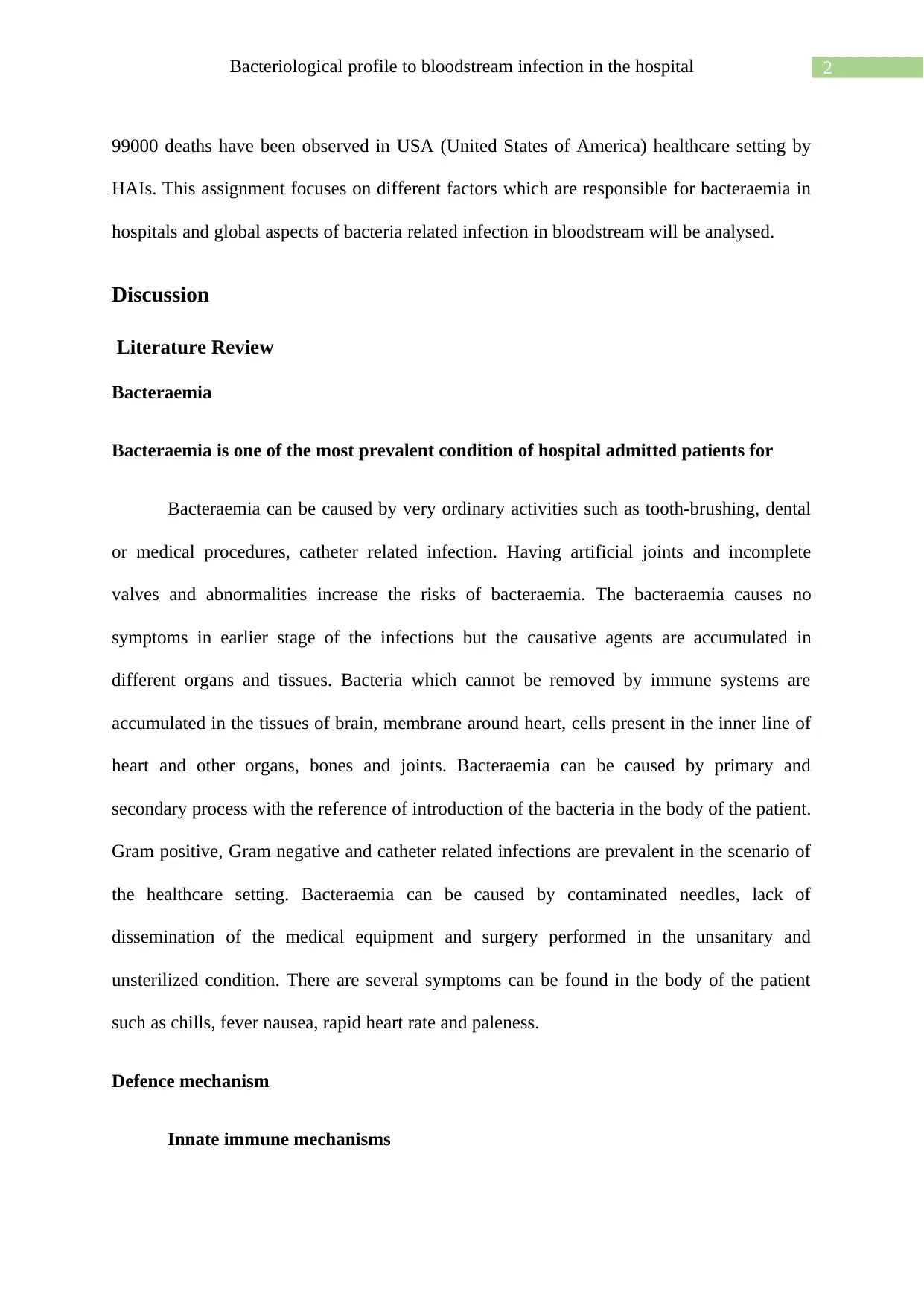
2Bacteriological profile to bloodstream infection in the hospital
99000 deaths have been observed in USA (United States of America) healthcare setting by
HAIs. This assignment focuses on different factors which are responsible for bacteraemia in
hospitals and global aspects of bacteria related infection in bloodstream will be analysed.
Discussion
Literature Review
Bacteraemia
Bacteraemia is one of the most prevalent condition of hospital admitted patients for
Bacteraemia can be caused by very ordinary activities such as tooth-brushing, dental
or medical procedures, catheter related infection. Having artificial joints and incomplete
valves and abnormalities increase the risks of bacteraemia. The bacteraemia causes no
symptoms in earlier stage of the infections but the causative agents are accumulated in
different organs and tissues. Bacteria which cannot be removed by immune systems are
accumulated in the tissues of brain, membrane around heart, cells present in the inner line of
heart and other organs, bones and joints. Bacteraemia can be caused by primary and
secondary process with the reference of introduction of the bacteria in the body of the patient.
Gram positive, Gram negative and catheter related infections are prevalent in the scenario of
the healthcare setting. Bacteraemia can be caused by contaminated needles, lack of
dissemination of the medical equipment and surgery performed in the unsanitary and
unsterilized condition. There are several symptoms can be found in the body of the patient
such as chills, fever nausea, rapid heart rate and paleness.
Defence mechanism
Innate immune mechanisms
99000 deaths have been observed in USA (United States of America) healthcare setting by
HAIs. This assignment focuses on different factors which are responsible for bacteraemia in
hospitals and global aspects of bacteria related infection in bloodstream will be analysed.
Discussion
Literature Review
Bacteraemia
Bacteraemia is one of the most prevalent condition of hospital admitted patients for
Bacteraemia can be caused by very ordinary activities such as tooth-brushing, dental
or medical procedures, catheter related infection. Having artificial joints and incomplete
valves and abnormalities increase the risks of bacteraemia. The bacteraemia causes no
symptoms in earlier stage of the infections but the causative agents are accumulated in
different organs and tissues. Bacteria which cannot be removed by immune systems are
accumulated in the tissues of brain, membrane around heart, cells present in the inner line of
heart and other organs, bones and joints. Bacteraemia can be caused by primary and
secondary process with the reference of introduction of the bacteria in the body of the patient.
Gram positive, Gram negative and catheter related infections are prevalent in the scenario of
the healthcare setting. Bacteraemia can be caused by contaminated needles, lack of
dissemination of the medical equipment and surgery performed in the unsanitary and
unsterilized condition. There are several symptoms can be found in the body of the patient
such as chills, fever nausea, rapid heart rate and paleness.
Defence mechanism
Innate immune mechanisms
⊘ This is a preview!⊘
Do you want full access?
Subscribe today to unlock all pages.

Trusted by 1+ million students worldwide
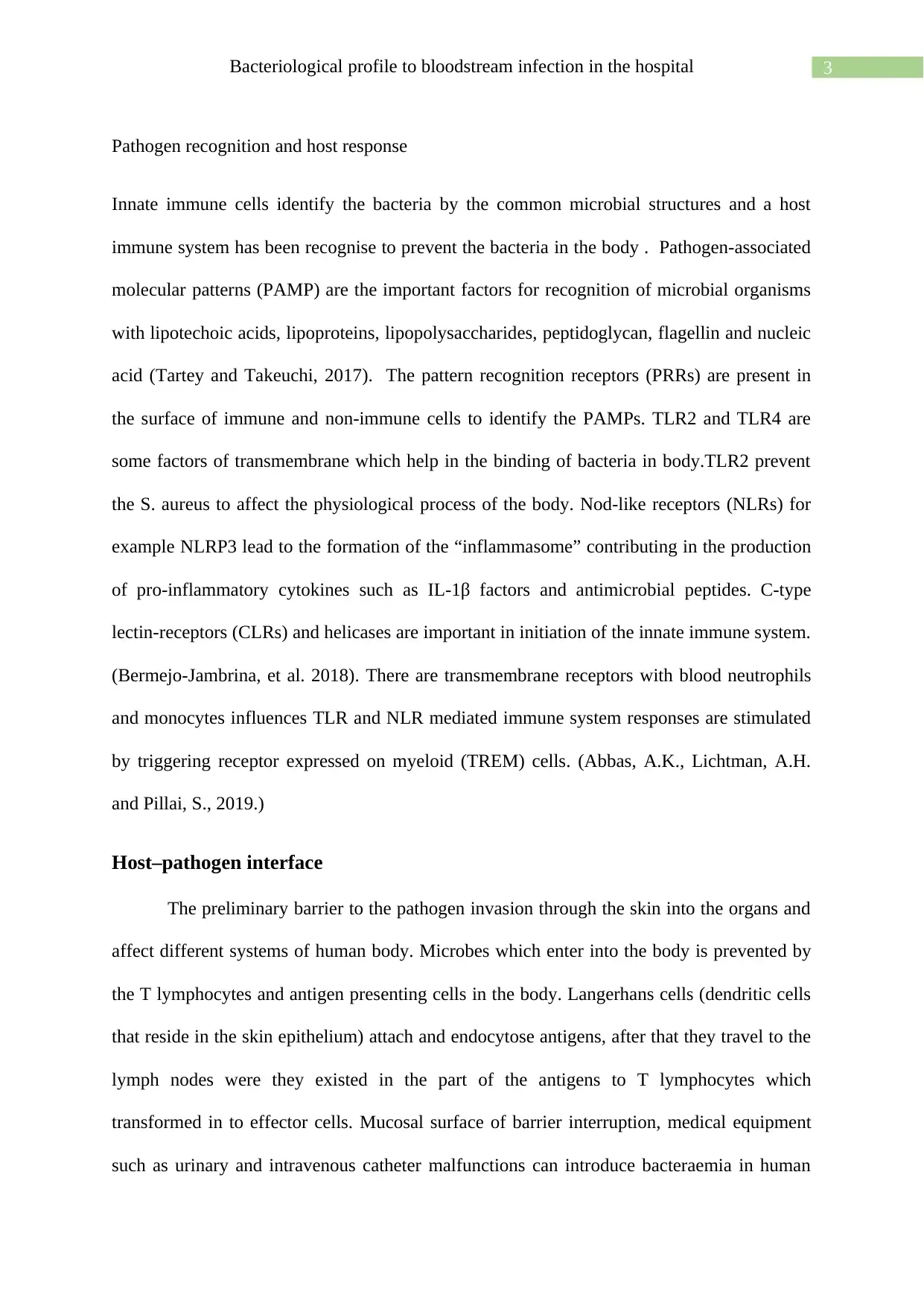
3Bacteriological profile to bloodstream infection in the hospital
Pathogen recognition and host response
Innate immune cells identify the bacteria by the common microbial structures and a host
immune system has been recognise to prevent the bacteria in the body . Pathogen-associated
molecular patterns (PAMP) are the important factors for recognition of microbial organisms
with lipotechoic acids, lipoproteins, lipopolysaccharides, peptidoglycan, flagellin and nucleic
acid (Tartey and Takeuchi, 2017). The pattern recognition receptors (PRRs) are present in
the surface of immune and non-immune cells to identify the PAMPs. TLR2 and TLR4 are
some factors of transmembrane which help in the binding of bacteria in body.TLR2 prevent
the S. aureus to affect the physiological process of the body. Nod-like receptors (NLRs) for
example NLRP3 lead to the formation of the “inflammasome” contributing in the production
of pro-inflammatory cytokines such as IL-1β factors and antimicrobial peptides. C-type
lectin-receptors (CLRs) and helicases are important in initiation of the innate immune system.
(Bermejo-Jambrina, et al. 2018). There are transmembrane receptors with blood neutrophils
and monocytes influences TLR and NLR mediated immune system responses are stimulated
by triggering receptor expressed on myeloid (TREM) cells. (Abbas, A.K., Lichtman, A.H.
and Pillai, S., 2019.)
Host–pathogen interface
The preliminary barrier to the pathogen invasion through the skin into the organs and
affect different systems of human body. Microbes which enter into the body is prevented by
the T lymphocytes and antigen presenting cells in the body. Langerhans cells (dendritic cells
that reside in the skin epithelium) attach and endocytose antigens, after that they travel to the
lymph nodes were they existed in the part of the antigens to T lymphocytes which
transformed in to effector cells. Mucosal surface of barrier interruption, medical equipment
such as urinary and intravenous catheter malfunctions can introduce bacteraemia in human
Pathogen recognition and host response
Innate immune cells identify the bacteria by the common microbial structures and a host
immune system has been recognise to prevent the bacteria in the body . Pathogen-associated
molecular patterns (PAMP) are the important factors for recognition of microbial organisms
with lipotechoic acids, lipoproteins, lipopolysaccharides, peptidoglycan, flagellin and nucleic
acid (Tartey and Takeuchi, 2017). The pattern recognition receptors (PRRs) are present in
the surface of immune and non-immune cells to identify the PAMPs. TLR2 and TLR4 are
some factors of transmembrane which help in the binding of bacteria in body.TLR2 prevent
the S. aureus to affect the physiological process of the body. Nod-like receptors (NLRs) for
example NLRP3 lead to the formation of the “inflammasome” contributing in the production
of pro-inflammatory cytokines such as IL-1β factors and antimicrobial peptides. C-type
lectin-receptors (CLRs) and helicases are important in initiation of the innate immune system.
(Bermejo-Jambrina, et al. 2018). There are transmembrane receptors with blood neutrophils
and monocytes influences TLR and NLR mediated immune system responses are stimulated
by triggering receptor expressed on myeloid (TREM) cells. (Abbas, A.K., Lichtman, A.H.
and Pillai, S., 2019.)
Host–pathogen interface
The preliminary barrier to the pathogen invasion through the skin into the organs and
affect different systems of human body. Microbes which enter into the body is prevented by
the T lymphocytes and antigen presenting cells in the body. Langerhans cells (dendritic cells
that reside in the skin epithelium) attach and endocytose antigens, after that they travel to the
lymph nodes were they existed in the part of the antigens to T lymphocytes which
transformed in to effector cells. Mucosal surface of barrier interruption, medical equipment
such as urinary and intravenous catheter malfunctions can introduce bacteraemia in human
Paraphrase This Document
Need a fresh take? Get an instant paraphrase of this document with our AI Paraphraser
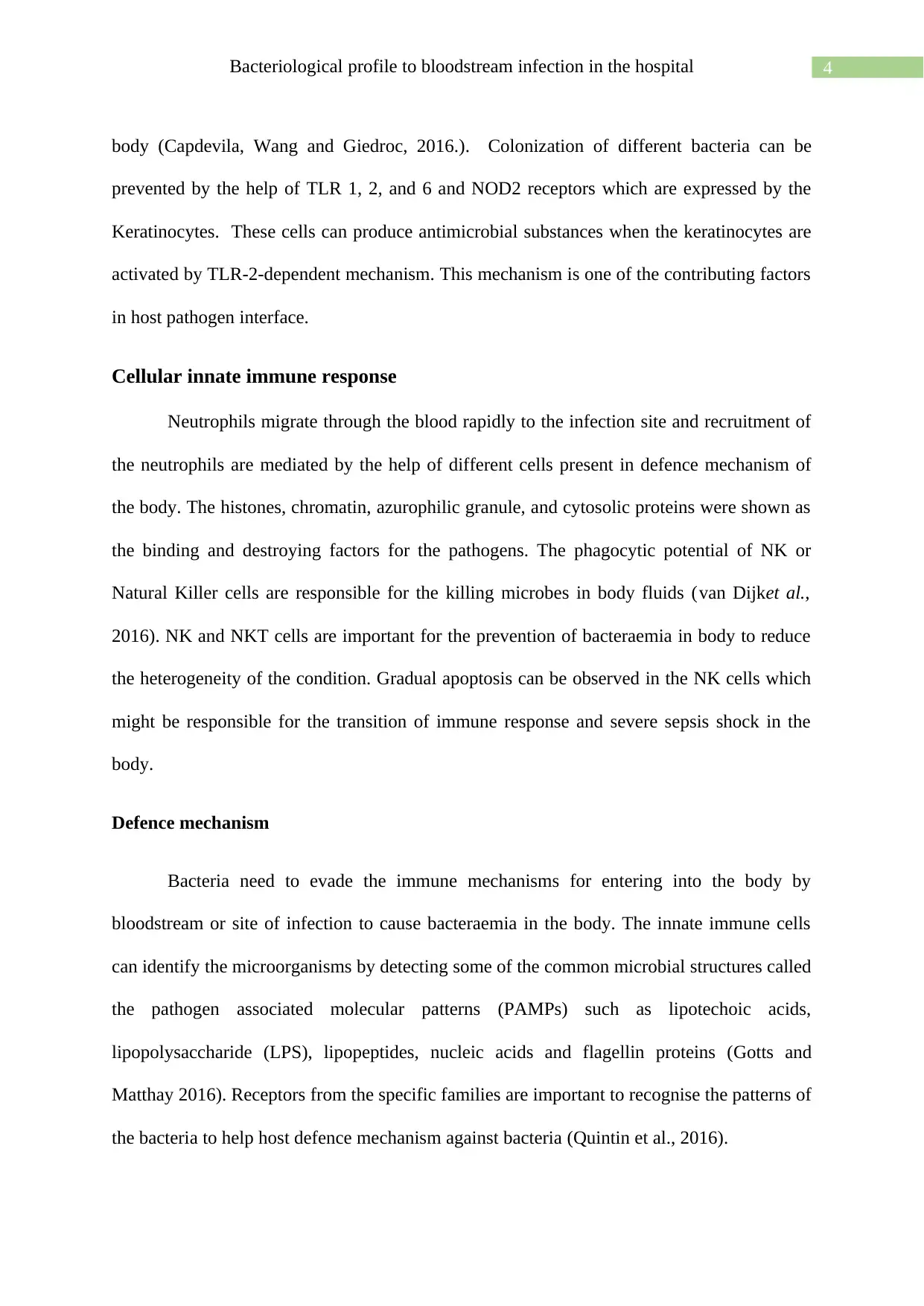
4Bacteriological profile to bloodstream infection in the hospital
body (Capdevila, Wang and Giedroc, 2016.). Colonization of different bacteria can be
prevented by the help of TLR 1, 2, and 6 and NOD2 receptors which are expressed by the
Keratinocytes. These cells can produce antimicrobial substances when the keratinocytes are
activated by TLR-2-dependent mechanism. This mechanism is one of the contributing factors
in host pathogen interface.
Cellular innate immune response
Neutrophils migrate through the blood rapidly to the infection site and recruitment of
the neutrophils are mediated by the help of different cells present in defence mechanism of
the body. The histones, chromatin, azurophilic granule, and cytosolic proteins were shown as
the binding and destroying factors for the pathogens. The phagocytic potential of NK or
Natural Killer cells are responsible for the killing microbes in body fluids (van Dijket al.,
2016). NK and NKT cells are important for the prevention of bacteraemia in body to reduce
the heterogeneity of the condition. Gradual apoptosis can be observed in the NK cells which
might be responsible for the transition of immune response and severe sepsis shock in the
body.
Defence mechanism
Bacteria need to evade the immune mechanisms for entering into the body by
bloodstream or site of infection to cause bacteraemia in the body. The innate immune cells
can identify the microorganisms by detecting some of the common microbial structures called
the pathogen associated molecular patterns (PAMPs) such as lipotechoic acids,
lipopolysaccharide (LPS), lipopeptides, nucleic acids and flagellin proteins (Gotts and
Matthay 2016). Receptors from the specific families are important to recognise the patterns of
the bacteria to help host defence mechanism against bacteria (Quintin et al., 2016).
body (Capdevila, Wang and Giedroc, 2016.). Colonization of different bacteria can be
prevented by the help of TLR 1, 2, and 6 and NOD2 receptors which are expressed by the
Keratinocytes. These cells can produce antimicrobial substances when the keratinocytes are
activated by TLR-2-dependent mechanism. This mechanism is one of the contributing factors
in host pathogen interface.
Cellular innate immune response
Neutrophils migrate through the blood rapidly to the infection site and recruitment of
the neutrophils are mediated by the help of different cells present in defence mechanism of
the body. The histones, chromatin, azurophilic granule, and cytosolic proteins were shown as
the binding and destroying factors for the pathogens. The phagocytic potential of NK or
Natural Killer cells are responsible for the killing microbes in body fluids (van Dijket al.,
2016). NK and NKT cells are important for the prevention of bacteraemia in body to reduce
the heterogeneity of the condition. Gradual apoptosis can be observed in the NK cells which
might be responsible for the transition of immune response and severe sepsis shock in the
body.
Defence mechanism
Bacteria need to evade the immune mechanisms for entering into the body by
bloodstream or site of infection to cause bacteraemia in the body. The innate immune cells
can identify the microorganisms by detecting some of the common microbial structures called
the pathogen associated molecular patterns (PAMPs) such as lipotechoic acids,
lipopolysaccharide (LPS), lipopeptides, nucleic acids and flagellin proteins (Gotts and
Matthay 2016). Receptors from the specific families are important to recognise the patterns of
the bacteria to help host defence mechanism against bacteria (Quintin et al., 2016).
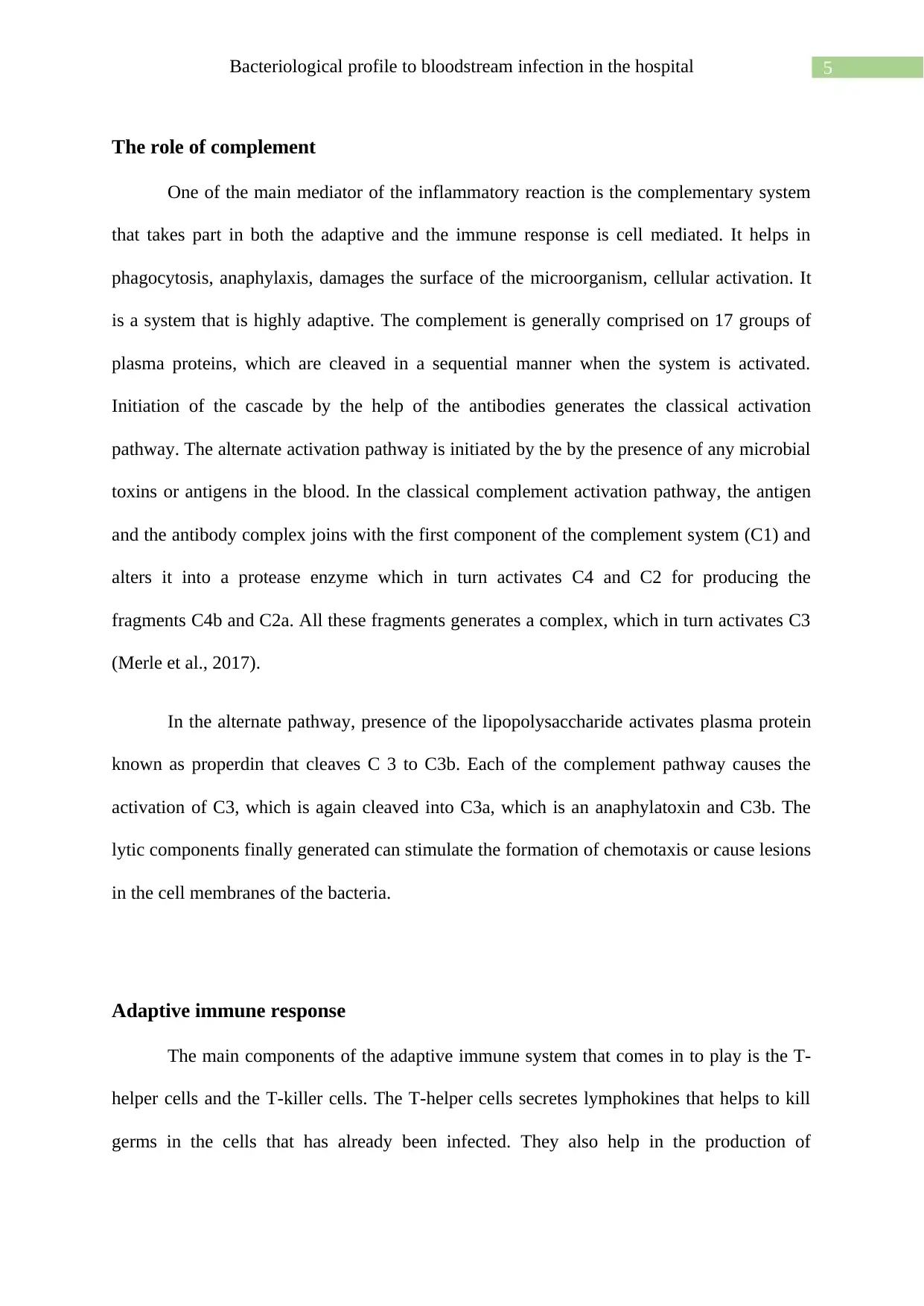
5Bacteriological profile to bloodstream infection in the hospital
The role of complement
One of the main mediator of the inflammatory reaction is the complementary system
that takes part in both the adaptive and the immune response is cell mediated. It helps in
phagocytosis, anaphylaxis, damages the surface of the microorganism, cellular activation. It
is a system that is highly adaptive. The complement is generally comprised on 17 groups of
plasma proteins, which are cleaved in a sequential manner when the system is activated.
Initiation of the cascade by the help of the antibodies generates the classical activation
pathway. The alternate activation pathway is initiated by the by the presence of any microbial
toxins or antigens in the blood. In the classical complement activation pathway, the antigen
and the antibody complex joins with the first component of the complement system (C1) and
alters it into a protease enzyme which in turn activates C4 and C2 for producing the
fragments C4b and C2a. All these fragments generates a complex, which in turn activates C3
(Merle et al., 2017).
In the alternate pathway, presence of the lipopolysaccharide activates plasma protein
known as properdin that cleaves C 3 to C3b. Each of the complement pathway causes the
activation of C3, which is again cleaved into C3a, which is an anaphylatoxin and C3b. The
lytic components finally generated can stimulate the formation of chemotaxis or cause lesions
in the cell membranes of the bacteria.
Adaptive immune response
The main components of the adaptive immune system that comes in to play is the T-
helper cells and the T-killer cells. The T-helper cells secretes lymphokines that helps to kill
germs in the cells that has already been infected. They also help in the production of
The role of complement
One of the main mediator of the inflammatory reaction is the complementary system
that takes part in both the adaptive and the immune response is cell mediated. It helps in
phagocytosis, anaphylaxis, damages the surface of the microorganism, cellular activation. It
is a system that is highly adaptive. The complement is generally comprised on 17 groups of
plasma proteins, which are cleaved in a sequential manner when the system is activated.
Initiation of the cascade by the help of the antibodies generates the classical activation
pathway. The alternate activation pathway is initiated by the by the presence of any microbial
toxins or antigens in the blood. In the classical complement activation pathway, the antigen
and the antibody complex joins with the first component of the complement system (C1) and
alters it into a protease enzyme which in turn activates C4 and C2 for producing the
fragments C4b and C2a. All these fragments generates a complex, which in turn activates C3
(Merle et al., 2017).
In the alternate pathway, presence of the lipopolysaccharide activates plasma protein
known as properdin that cleaves C 3 to C3b. Each of the complement pathway causes the
activation of C3, which is again cleaved into C3a, which is an anaphylatoxin and C3b. The
lytic components finally generated can stimulate the formation of chemotaxis or cause lesions
in the cell membranes of the bacteria.
Adaptive immune response
The main components of the adaptive immune system that comes in to play is the T-
helper cells and the T-killer cells. The T-helper cells secretes lymphokines that helps to kill
germs in the cells that has already been infected. They also help in the production of
⊘ This is a preview!⊘
Do you want full access?
Subscribe today to unlock all pages.

Trusted by 1+ million students worldwide
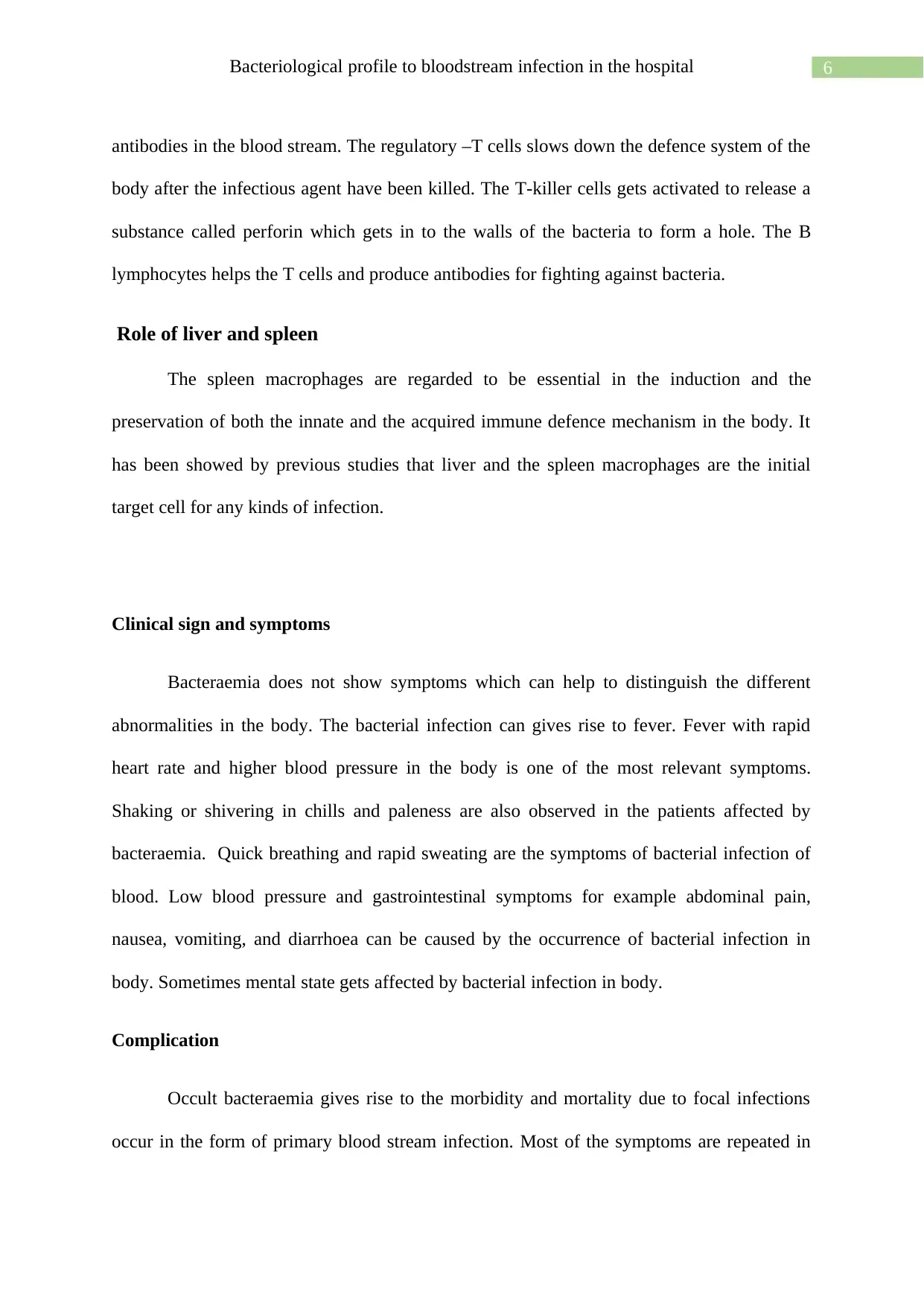
6Bacteriological profile to bloodstream infection in the hospital
antibodies in the blood stream. The regulatory –T cells slows down the defence system of the
body after the infectious agent have been killed. The T-killer cells gets activated to release a
substance called perforin which gets in to the walls of the bacteria to form a hole. The B
lymphocytes helps the T cells and produce antibodies for fighting against bacteria.
Role of liver and spleen
The spleen macrophages are regarded to be essential in the induction and the
preservation of both the innate and the acquired immune defence mechanism in the body. It
has been showed by previous studies that liver and the spleen macrophages are the initial
target cell for any kinds of infection.
Clinical sign and symptoms
Bacteraemia does not show symptoms which can help to distinguish the different
abnormalities in the body. The bacterial infection can gives rise to fever. Fever with rapid
heart rate and higher blood pressure in the body is one of the most relevant symptoms.
Shaking or shivering in chills and paleness are also observed in the patients affected by
bacteraemia. Quick breathing and rapid sweating are the symptoms of bacterial infection of
blood. Low blood pressure and gastrointestinal symptoms for example abdominal pain,
nausea, vomiting, and diarrhoea can be caused by the occurrence of bacterial infection in
body. Sometimes mental state gets affected by bacterial infection in body.
Complication
Occult bacteraemia gives rise to the morbidity and mortality due to focal infections
occur in the form of primary blood stream infection. Most of the symptoms are repeated in
antibodies in the blood stream. The regulatory –T cells slows down the defence system of the
body after the infectious agent have been killed. The T-killer cells gets activated to release a
substance called perforin which gets in to the walls of the bacteria to form a hole. The B
lymphocytes helps the T cells and produce antibodies for fighting against bacteria.
Role of liver and spleen
The spleen macrophages are regarded to be essential in the induction and the
preservation of both the innate and the acquired immune defence mechanism in the body. It
has been showed by previous studies that liver and the spleen macrophages are the initial
target cell for any kinds of infection.
Clinical sign and symptoms
Bacteraemia does not show symptoms which can help to distinguish the different
abnormalities in the body. The bacterial infection can gives rise to fever. Fever with rapid
heart rate and higher blood pressure in the body is one of the most relevant symptoms.
Shaking or shivering in chills and paleness are also observed in the patients affected by
bacteraemia. Quick breathing and rapid sweating are the symptoms of bacterial infection of
blood. Low blood pressure and gastrointestinal symptoms for example abdominal pain,
nausea, vomiting, and diarrhoea can be caused by the occurrence of bacterial infection in
body. Sometimes mental state gets affected by bacterial infection in body.
Complication
Occult bacteraemia gives rise to the morbidity and mortality due to focal infections
occur in the form of primary blood stream infection. Most of the symptoms are repeated in
Paraphrase This Document
Need a fresh take? Get an instant paraphrase of this document with our AI Paraphraser
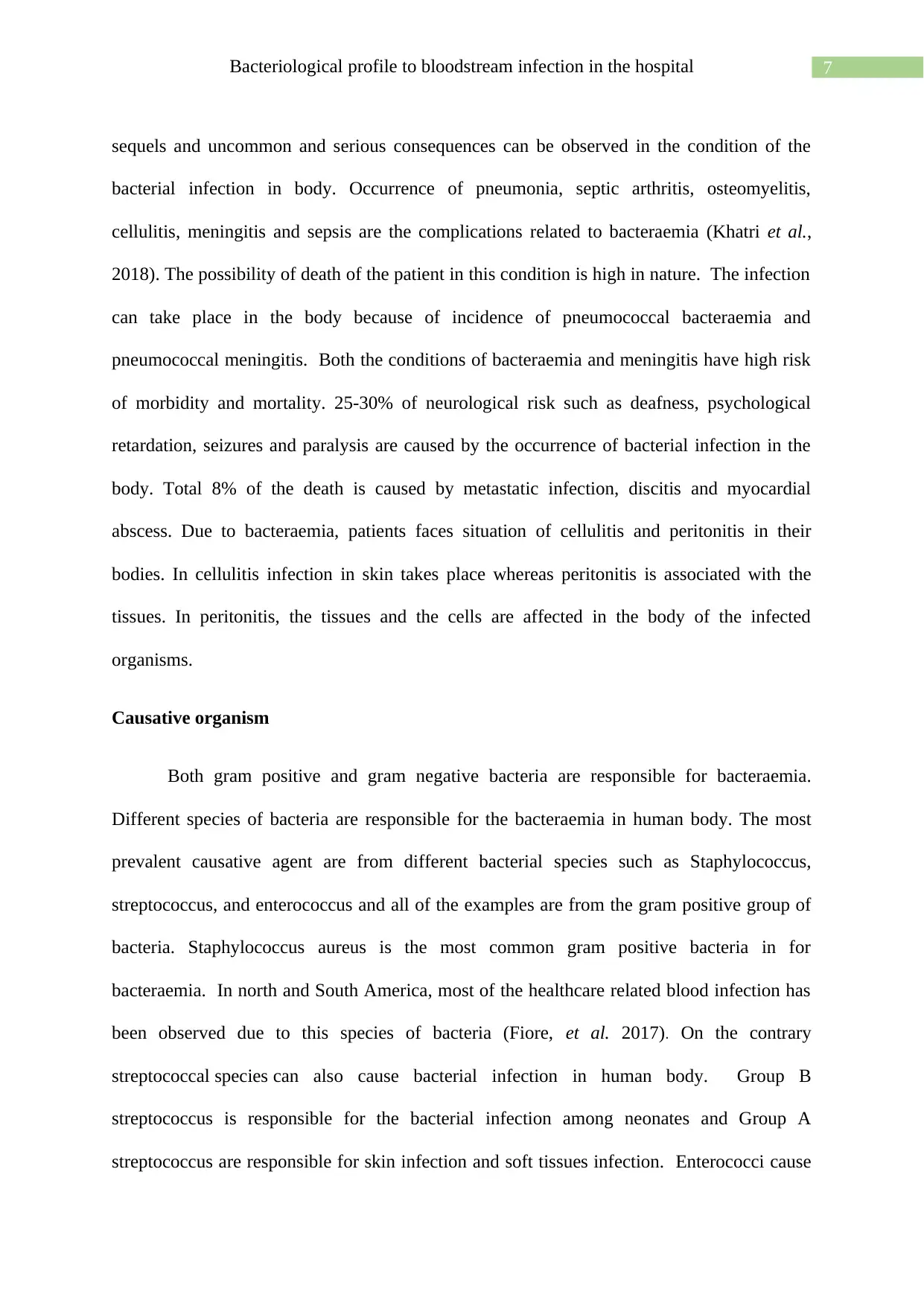
7Bacteriological profile to bloodstream infection in the hospital
sequels and uncommon and serious consequences can be observed in the condition of the
bacterial infection in body. Occurrence of pneumonia, septic arthritis, osteomyelitis,
cellulitis, meningitis and sepsis are the complications related to bacteraemia (Khatri et al.,
2018). The possibility of death of the patient in this condition is high in nature. The infection
can take place in the body because of incidence of pneumococcal bacteraemia and
pneumococcal meningitis. Both the conditions of bacteraemia and meningitis have high risk
of morbidity and mortality. 25-30% of neurological risk such as deafness, psychological
retardation, seizures and paralysis are caused by the occurrence of bacterial infection in the
body. Total 8% of the death is caused by metastatic infection, discitis and myocardial
abscess. Due to bacteraemia, patients faces situation of cellulitis and peritonitis in their
bodies. In cellulitis infection in skin takes place whereas peritonitis is associated with the
tissues. In peritonitis, the tissues and the cells are affected in the body of the infected
organisms.
Causative organism
Both gram positive and gram negative bacteria are responsible for bacteraemia.
Different species of bacteria are responsible for the bacteraemia in human body. The most
prevalent causative agent are from different bacterial species such as Staphylococcus,
streptococcus, and enterococcus and all of the examples are from the gram positive group of
bacteria. Staphylococcus aureus is the most common gram positive bacteria in for
bacteraemia. In north and South America, most of the healthcare related blood infection has
been observed due to this species of bacteria (Fiore, et al. 2017). On the contrary
streptococcal species can also cause bacterial infection in human body. Group B
streptococcus is responsible for the bacterial infection among neonates and Group A
streptococcus are responsible for skin infection and soft tissues infection. Enterococci cause
sequels and uncommon and serious consequences can be observed in the condition of the
bacterial infection in body. Occurrence of pneumonia, septic arthritis, osteomyelitis,
cellulitis, meningitis and sepsis are the complications related to bacteraemia (Khatri et al.,
2018). The possibility of death of the patient in this condition is high in nature. The infection
can take place in the body because of incidence of pneumococcal bacteraemia and
pneumococcal meningitis. Both the conditions of bacteraemia and meningitis have high risk
of morbidity and mortality. 25-30% of neurological risk such as deafness, psychological
retardation, seizures and paralysis are caused by the occurrence of bacterial infection in the
body. Total 8% of the death is caused by metastatic infection, discitis and myocardial
abscess. Due to bacteraemia, patients faces situation of cellulitis and peritonitis in their
bodies. In cellulitis infection in skin takes place whereas peritonitis is associated with the
tissues. In peritonitis, the tissues and the cells are affected in the body of the infected
organisms.
Causative organism
Both gram positive and gram negative bacteria are responsible for bacteraemia.
Different species of bacteria are responsible for the bacteraemia in human body. The most
prevalent causative agent are from different bacterial species such as Staphylococcus,
streptococcus, and enterococcus and all of the examples are from the gram positive group of
bacteria. Staphylococcus aureus is the most common gram positive bacteria in for
bacteraemia. In north and South America, most of the healthcare related blood infection has
been observed due to this species of bacteria (Fiore, et al. 2017). On the contrary
streptococcal species can also cause bacterial infection in human body. Group B
streptococcus is responsible for the bacterial infection among neonates and Group A
streptococcus are responsible for skin infection and soft tissues infection. Enterococci cause
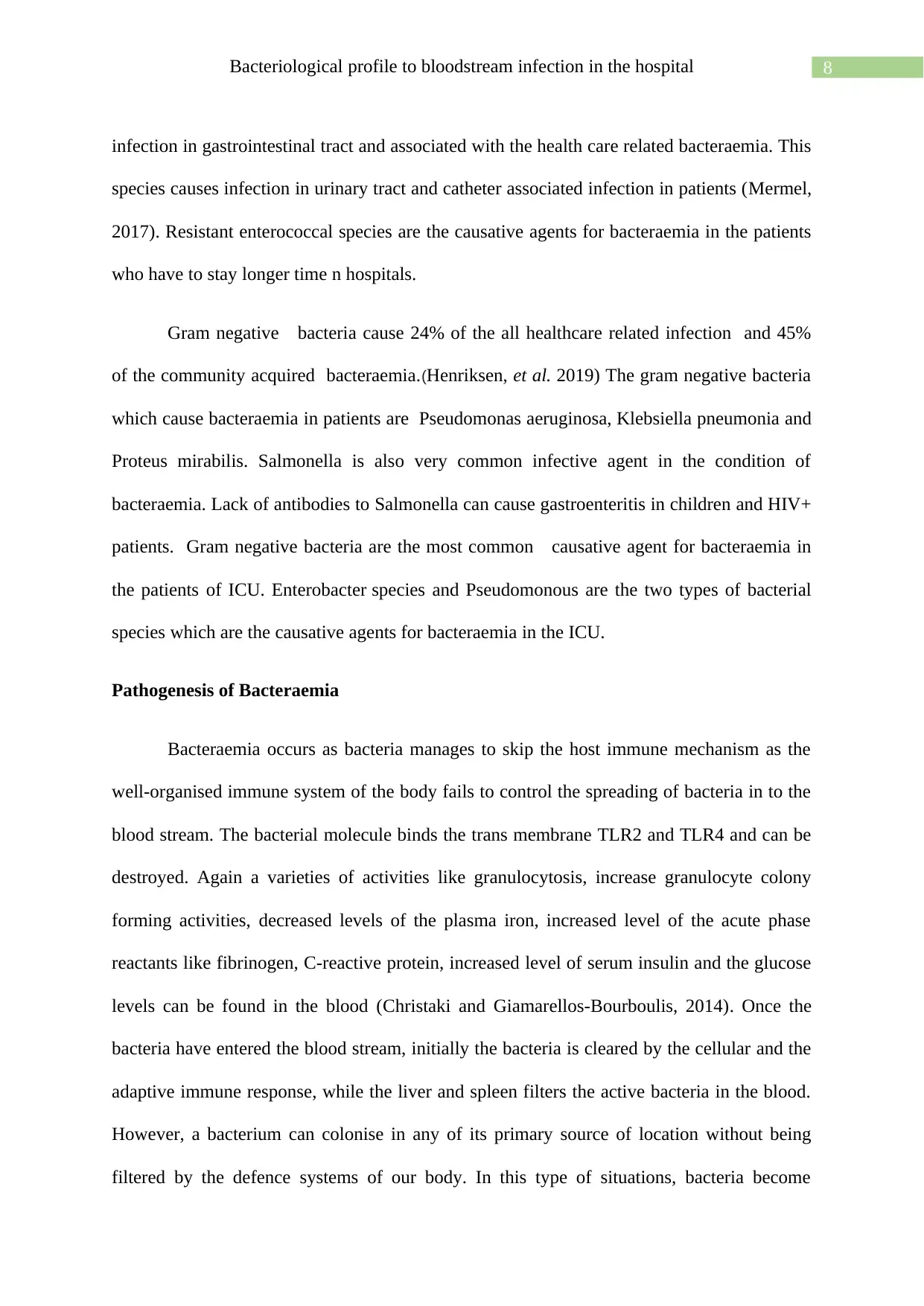
8Bacteriological profile to bloodstream infection in the hospital
infection in gastrointestinal tract and associated with the health care related bacteraemia. This
species causes infection in urinary tract and catheter associated infection in patients (Mermel,
2017). Resistant enterococcal species are the causative agents for bacteraemia in the patients
who have to stay longer time n hospitals.
Gram negative bacteria cause 24% of the all healthcare related infection and 45%
of the community acquired bacteraemia.(Henriksen, et al. 2019) The gram negative bacteria
which cause bacteraemia in patients are Pseudomonas aeruginosa, Klebsiella pneumonia and
Proteus mirabilis. Salmonella is also very common infective agent in the condition of
bacteraemia. Lack of antibodies to Salmonella can cause gastroenteritis in children and HIV+
patients. Gram negative bacteria are the most common causative agent for bacteraemia in
the patients of ICU. Enterobacter species and Pseudomonous are the two types of bacterial
species which are the causative agents for bacteraemia in the ICU.
Pathogenesis of Bacteraemia
Bacteraemia occurs as bacteria manages to skip the host immune mechanism as the
well-organised immune system of the body fails to control the spreading of bacteria in to the
blood stream. The bacterial molecule binds the trans membrane TLR2 and TLR4 and can be
destroyed. Again a varieties of activities like granulocytosis, increase granulocyte colony
forming activities, decreased levels of the plasma iron, increased level of the acute phase
reactants like fibrinogen, C-reactive protein, increased level of serum insulin and the glucose
levels can be found in the blood (Christaki and Giamarellos-Bourboulis, 2014). Once the
bacteria have entered the blood stream, initially the bacteria is cleared by the cellular and the
adaptive immune response, while the liver and spleen filters the active bacteria in the blood.
However, a bacterium can colonise in any of its primary source of location without being
filtered by the defence systems of our body. In this type of situations, bacteria become
infection in gastrointestinal tract and associated with the health care related bacteraemia. This
species causes infection in urinary tract and catheter associated infection in patients (Mermel,
2017). Resistant enterococcal species are the causative agents for bacteraemia in the patients
who have to stay longer time n hospitals.
Gram negative bacteria cause 24% of the all healthcare related infection and 45%
of the community acquired bacteraemia.(Henriksen, et al. 2019) The gram negative bacteria
which cause bacteraemia in patients are Pseudomonas aeruginosa, Klebsiella pneumonia and
Proteus mirabilis. Salmonella is also very common infective agent in the condition of
bacteraemia. Lack of antibodies to Salmonella can cause gastroenteritis in children and HIV+
patients. Gram negative bacteria are the most common causative agent for bacteraemia in
the patients of ICU. Enterobacter species and Pseudomonous are the two types of bacterial
species which are the causative agents for bacteraemia in the ICU.
Pathogenesis of Bacteraemia
Bacteraemia occurs as bacteria manages to skip the host immune mechanism as the
well-organised immune system of the body fails to control the spreading of bacteria in to the
blood stream. The bacterial molecule binds the trans membrane TLR2 and TLR4 and can be
destroyed. Again a varieties of activities like granulocytosis, increase granulocyte colony
forming activities, decreased levels of the plasma iron, increased level of the acute phase
reactants like fibrinogen, C-reactive protein, increased level of serum insulin and the glucose
levels can be found in the blood (Christaki and Giamarellos-Bourboulis, 2014). Once the
bacteria have entered the blood stream, initially the bacteria is cleared by the cellular and the
adaptive immune response, while the liver and spleen filters the active bacteria in the blood.
However, a bacterium can colonise in any of its primary source of location without being
filtered by the defence systems of our body. In this type of situations, bacteria become
⊘ This is a preview!⊘
Do you want full access?
Subscribe today to unlock all pages.

Trusted by 1+ million students worldwide
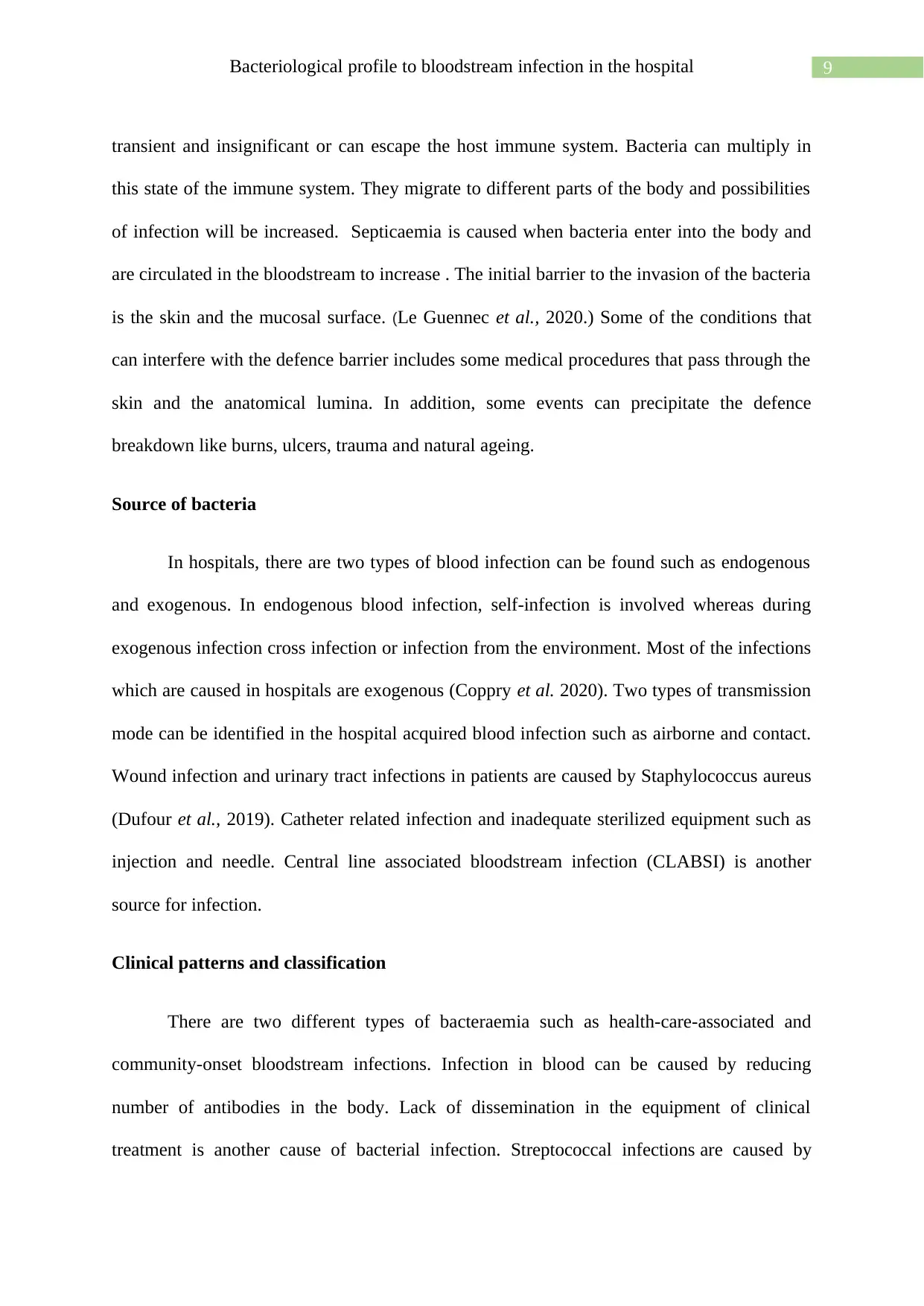
9Bacteriological profile to bloodstream infection in the hospital
transient and insignificant or can escape the host immune system. Bacteria can multiply in
this state of the immune system. They migrate to different parts of the body and possibilities
of infection will be increased. Septicaemia is caused when bacteria enter into the body and
are circulated in the bloodstream to increase . The initial barrier to the invasion of the bacteria
is the skin and the mucosal surface. (Le Guennec et al., 2020.) Some of the conditions that
can interfere with the defence barrier includes some medical procedures that pass through the
skin and the anatomical lumina. In addition, some events can precipitate the defence
breakdown like burns, ulcers, trauma and natural ageing.
Source of bacteria
In hospitals, there are two types of blood infection can be found such as endogenous
and exogenous. In endogenous blood infection, self-infection is involved whereas during
exogenous infection cross infection or infection from the environment. Most of the infections
which are caused in hospitals are exogenous (Coppry et al. 2020). Two types of transmission
mode can be identified in the hospital acquired blood infection such as airborne and contact.
Wound infection and urinary tract infections in patients are caused by Staphylococcus aureus
(Dufour et al., 2019). Catheter related infection and inadequate sterilized equipment such as
injection and needle. Central line associated bloodstream infection (CLABSI) is another
source for infection.
Clinical patterns and classification
There are two different types of bacteraemia such as health-care-associated and
community-onset bloodstream infections. Infection in blood can be caused by reducing
number of antibodies in the body. Lack of dissemination in the equipment of clinical
treatment is another cause of bacterial infection. Streptococcal infections are caused by
transient and insignificant or can escape the host immune system. Bacteria can multiply in
this state of the immune system. They migrate to different parts of the body and possibilities
of infection will be increased. Septicaemia is caused when bacteria enter into the body and
are circulated in the bloodstream to increase . The initial barrier to the invasion of the bacteria
is the skin and the mucosal surface. (Le Guennec et al., 2020.) Some of the conditions that
can interfere with the defence barrier includes some medical procedures that pass through the
skin and the anatomical lumina. In addition, some events can precipitate the defence
breakdown like burns, ulcers, trauma and natural ageing.
Source of bacteria
In hospitals, there are two types of blood infection can be found such as endogenous
and exogenous. In endogenous blood infection, self-infection is involved whereas during
exogenous infection cross infection or infection from the environment. Most of the infections
which are caused in hospitals are exogenous (Coppry et al. 2020). Two types of transmission
mode can be identified in the hospital acquired blood infection such as airborne and contact.
Wound infection and urinary tract infections in patients are caused by Staphylococcus aureus
(Dufour et al., 2019). Catheter related infection and inadequate sterilized equipment such as
injection and needle. Central line associated bloodstream infection (CLABSI) is another
source for infection.
Clinical patterns and classification
There are two different types of bacteraemia such as health-care-associated and
community-onset bloodstream infections. Infection in blood can be caused by reducing
number of antibodies in the body. Lack of dissemination in the equipment of clinical
treatment is another cause of bacterial infection. Streptococcal infections are caused by
Paraphrase This Document
Need a fresh take? Get an instant paraphrase of this document with our AI Paraphraser
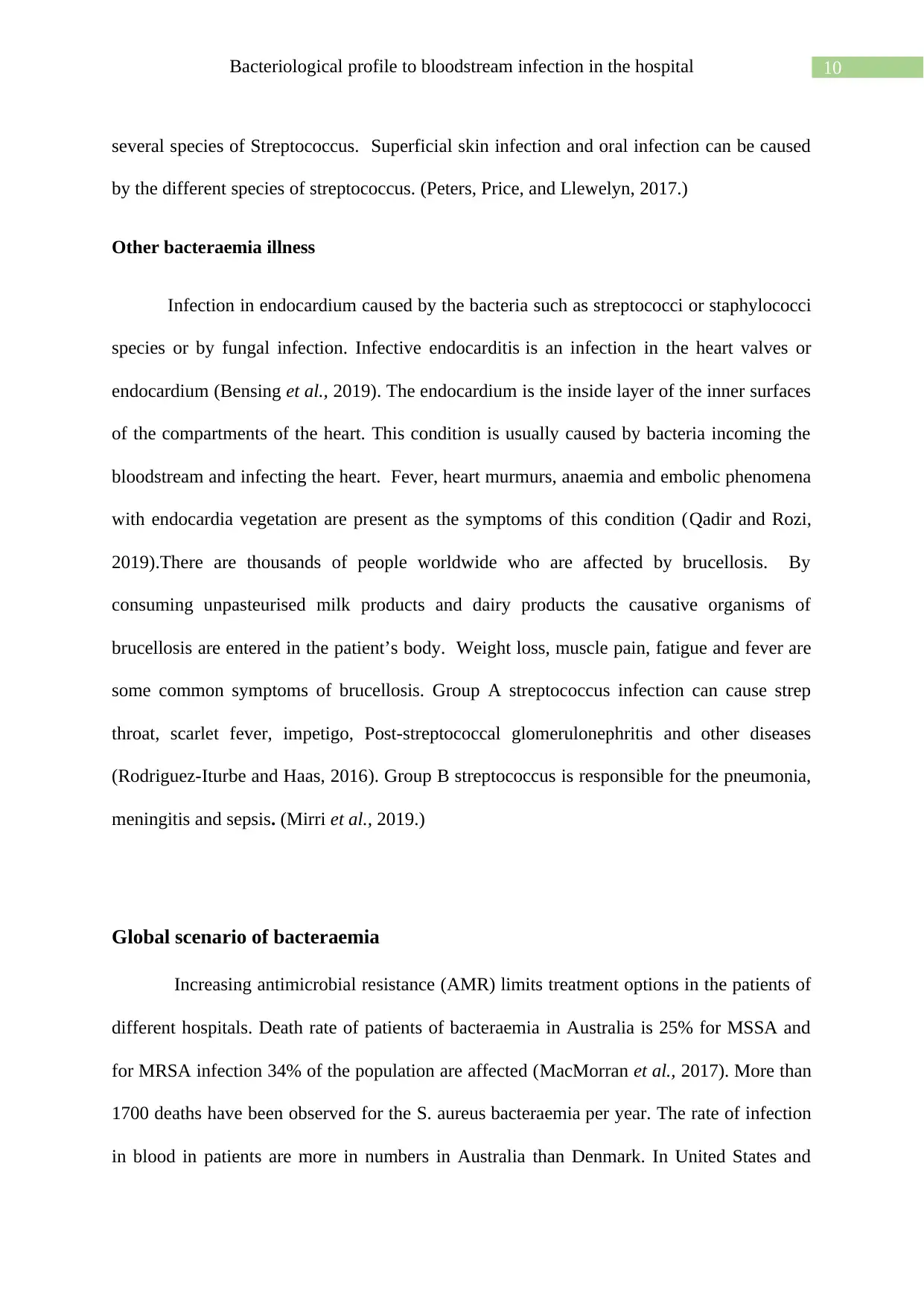
10Bacteriological profile to bloodstream infection in the hospital
several species of Streptococcus. Superficial skin infection and oral infection can be caused
by the different species of streptococcus. (Peters, Price, and Llewelyn, 2017.)
Other bacteraemia illness
Infection in endocardium caused by the bacteria such as streptococci or staphylococci
species or by fungal infection. Infective endocarditis is an infection in the heart valves or
endocardium (Bensing et al., 2019). The endocardium is the inside layer of the inner surfaces
of the compartments of the heart. This condition is usually caused by bacteria incoming the
bloodstream and infecting the heart. Fever, heart murmurs, anaemia and embolic phenomena
with endocardia vegetation are present as the symptoms of this condition (Qadir and Rozi,
2019).There are thousands of people worldwide who are affected by brucellosis. By
consuming unpasteurised milk products and dairy products the causative organisms of
brucellosis are entered in the patient’s body. Weight loss, muscle pain, fatigue and fever are
some common symptoms of brucellosis. Group A streptococcus infection can cause strep
throat, scarlet fever, impetigo, Post-streptococcal glomerulonephritis and other diseases
(Rodriguez-Iturbe and Haas, 2016). Group B streptococcus is responsible for the pneumonia,
meningitis and sepsis. (Mirri et al., 2019.)
Global scenario of bacteraemia
Increasing antimicrobial resistance (AMR) limits treatment options in the patients of
different hospitals. Death rate of patients of bacteraemia in Australia is 25% for MSSA and
for MRSA infection 34% of the population are affected (MacMorran et al., 2017). More than
1700 deaths have been observed for the S. aureus bacteraemia per year. The rate of infection
in blood in patients are more in numbers in Australia than Denmark. In United States and
several species of Streptococcus. Superficial skin infection and oral infection can be caused
by the different species of streptococcus. (Peters, Price, and Llewelyn, 2017.)
Other bacteraemia illness
Infection in endocardium caused by the bacteria such as streptococci or staphylococci
species or by fungal infection. Infective endocarditis is an infection in the heart valves or
endocardium (Bensing et al., 2019). The endocardium is the inside layer of the inner surfaces
of the compartments of the heart. This condition is usually caused by bacteria incoming the
bloodstream and infecting the heart. Fever, heart murmurs, anaemia and embolic phenomena
with endocardia vegetation are present as the symptoms of this condition (Qadir and Rozi,
2019).There are thousands of people worldwide who are affected by brucellosis. By
consuming unpasteurised milk products and dairy products the causative organisms of
brucellosis are entered in the patient’s body. Weight loss, muscle pain, fatigue and fever are
some common symptoms of brucellosis. Group A streptococcus infection can cause strep
throat, scarlet fever, impetigo, Post-streptococcal glomerulonephritis and other diseases
(Rodriguez-Iturbe and Haas, 2016). Group B streptococcus is responsible for the pneumonia,
meningitis and sepsis. (Mirri et al., 2019.)
Global scenario of bacteraemia
Increasing antimicrobial resistance (AMR) limits treatment options in the patients of
different hospitals. Death rate of patients of bacteraemia in Australia is 25% for MSSA and
for MRSA infection 34% of the population are affected (MacMorran et al., 2017). More than
1700 deaths have been observed for the S. aureus bacteraemia per year. The rate of infection
in blood in patients are more in numbers in Australia than Denmark. In United States and
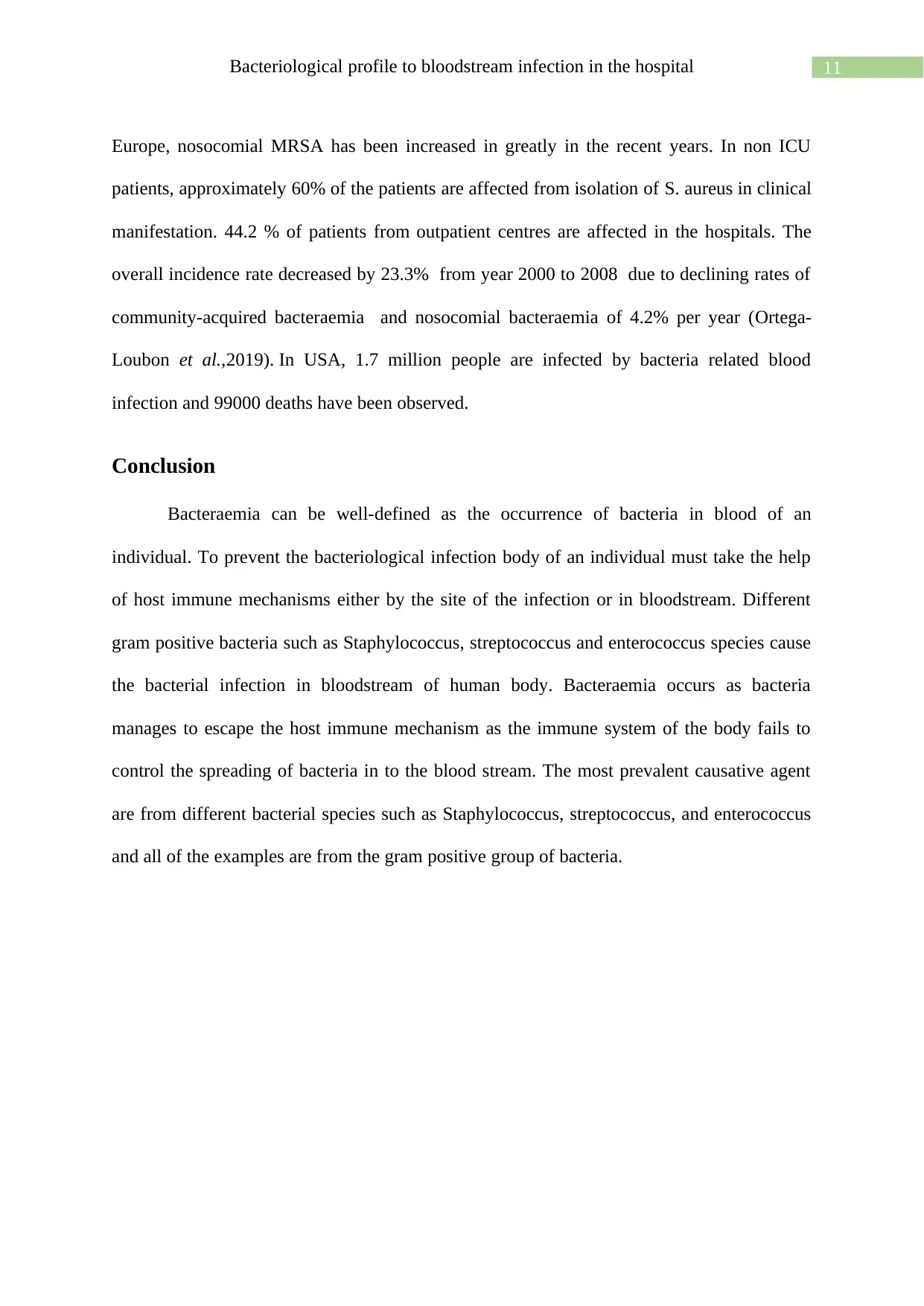
11Bacteriological profile to bloodstream infection in the hospital
Europe, nosocomial MRSA has been increased in greatly in the recent years. In non ICU
patients, approximately 60% of the patients are affected from isolation of S. aureus in clinical
manifestation. 44.2 % of patients from outpatient centres are affected in the hospitals. The
overall incidence rate decreased by 23.3% from year 2000 to 2008 due to declining rates of
community-acquired bacteraemia and nosocomial bacteraemia of 4.2% per year (Ortega-
Loubon et al.,2019). In USA, 1.7 million people are infected by bacteria related blood
infection and 99000 deaths have been observed.
Conclusion
Bacteraemia can be well-defined as the occurrence of bacteria in blood of an
individual. To prevent the bacteriological infection body of an individual must take the help
of host immune mechanisms either by the site of the infection or in bloodstream. Different
gram positive bacteria such as Staphylococcus, streptococcus and enterococcus species cause
the bacterial infection in bloodstream of human body. Bacteraemia occurs as bacteria
manages to escape the host immune mechanism as the immune system of the body fails to
control the spreading of bacteria in to the blood stream. The most prevalent causative agent
are from different bacterial species such as Staphylococcus, streptococcus, and enterococcus
and all of the examples are from the gram positive group of bacteria.
Europe, nosocomial MRSA has been increased in greatly in the recent years. In non ICU
patients, approximately 60% of the patients are affected from isolation of S. aureus in clinical
manifestation. 44.2 % of patients from outpatient centres are affected in the hospitals. The
overall incidence rate decreased by 23.3% from year 2000 to 2008 due to declining rates of
community-acquired bacteraemia and nosocomial bacteraemia of 4.2% per year (Ortega-
Loubon et al.,2019). In USA, 1.7 million people are infected by bacteria related blood
infection and 99000 deaths have been observed.
Conclusion
Bacteraemia can be well-defined as the occurrence of bacteria in blood of an
individual. To prevent the bacteriological infection body of an individual must take the help
of host immune mechanisms either by the site of the infection or in bloodstream. Different
gram positive bacteria such as Staphylococcus, streptococcus and enterococcus species cause
the bacterial infection in bloodstream of human body. Bacteraemia occurs as bacteria
manages to escape the host immune mechanism as the immune system of the body fails to
control the spreading of bacteria in to the blood stream. The most prevalent causative agent
are from different bacterial species such as Staphylococcus, streptococcus, and enterococcus
and all of the examples are from the gram positive group of bacteria.
⊘ This is a preview!⊘
Do you want full access?
Subscribe today to unlock all pages.

Trusted by 1+ million students worldwide
1 out of 16
Related Documents
Your All-in-One AI-Powered Toolkit for Academic Success.
+13062052269
info@desklib.com
Available 24*7 on WhatsApp / Email
![[object Object]](/_next/static/media/star-bottom.7253800d.svg)
Unlock your academic potential
Copyright © 2020–2025 A2Z Services. All Rights Reserved. Developed and managed by ZUCOL.





